Selected Geoheritage Resources of “Atlantic Geopark” Project (Central Portugal)
Abstract
1. Introduction
2. Geographical and Geological Setting
2.1. Iberian Massif
2.2. Lusitanian Basin
3. Geological Milestones Displayed at the “Atlantic Geopark” Project
4. Selected Geoheritage Resources of the “Atlantic Geopark” Project
4.1. “Livraria do Mondego”: The Beginning of the Rheic Ocean (477–470 Ma)
4.2. Santa Cristina Foutain: Nestled Amidst Towering Mountains (315–303 Ma)
4.3. “Pedra de Ançã”: The Carbonate Platform of the Proto-North Atlantic (170 Ma)
4.4. Cape Mondego: The Opening of the North Atlantic Ocean (184–149 Ma)
4.5. Castle of Montemor-o-Velho Viewpoint: A Cultural Landscape (1.80 Ma)
4.6. “Lagoa da Barrinha”: The Current Atlantic Margin (0.0056 Ma)
5. A Geo-Itinerary for All
6. Discussion
7. Conclusions
Author Contributions
Funding
Acknowledgments
Conflicts of Interest
References
- Carcavilla, L.; López-Martínez, J.; Durán, J.J. Patrimonio Geológico y Geodiversidad: Investigación, Conservación, Gestión y Relación Con Los Espácios Naturales Protegidos, 1st ed.; Instituto Geológico y Minero de España: Madrid, Spain, 2007; p. 360. [Google Scholar]
- Cairncross, B. The national heritage resource act (1999): Can legislation protect South Africa’s rare geoheritage resources? Resour. Policy 2011, 36, 204–2013. [Google Scholar] [CrossRef]
- Ruban, D.A.; Mikhailenko, A.V.; Yashalova, N.M. Valuable geoheritage resources: Potential versus exploitation. Resour. Policy 2022, 77, 102665. [Google Scholar] [CrossRef]
- Sallam, E.S.; Ruban, D.A.; Ermolaev, V.A. Geoheritage resources and new direction of infrastructural growth in Egypt: From geosite assessment to policy development. Resour. Policy 2022, 79, 103127. [Google Scholar] [CrossRef]
- UNESCO Global Geoparks. Available online: https://www.unesco.org/en/iggp/geoparks/about (accessed on 14 January 2024).
- Guidelines and Criteria for National Geoparks seeking UNESCO’s Assistance to join the Global Geoparks Network. Available online: https://www.europeangeoparks.org/?page_id=633 (accessed on 14 January 2024).
- Guidelines for the Assessment of the International Significance of Geological Heritage in UNESCO Global Geopark Applications. Available online: https://unesdoc.unesco.org/ark:/48223/pf0000386952 (accessed on 14 January 2024).
- Romão, J.; Metodiev, D.; Dias, R.; Ribeiro, A. Evolução geodinâmica dos sectores meridionais da Zona Centro Ibérica. In Geologia de Portugal, 1st ed.; Dias, R., Araújo, A., Terrinha, P., Kullberg, J.C., Eds.; Escolar Editora: Lisboa, Portugal, 2013; Volume I, pp. 149–203. [Google Scholar]
- Azaredo, A.C.; Duarte, L.V.; Henriques, M.H.; Manuppella, G. Da dinâmica continental no Triásico aos mares do Jurássico Inferior e Médio. Cad. Geol. Portugal 2003, 1, 7–43. [Google Scholar]
- Censos. 2021. Available online: https://censos.ine.pt/xportal/xmain?xpgid=censos21_dados&xpid=CENSOS21&xlang=pt (accessed on 29 July 2022).
- Google Earth. Available online: https://earth.google.com/web/@38.84673007,-8.3706209,108.5238643a,191970.92537703d,35y,0h,0t,0r/data=OgMKATA (accessed on 5 March 2024).
- Vaz, N.; Rosado-González, E.; Lourenço, J.; Correia, P.; Custódio, S.; Henriques, M.H.; Sá, A.A. Projeto Geoparque Atlântico–um compêndio com mais de 600milhões de anos de geodiversidade. In Livro de Roteiros das Excursões do XI Congresso Nacional de Geologia “Geociências e Desafios Globais”; Font, E., Dinis, P.A., Lopes, F.C., Eds.; Universidade de Coimbra: Coimbra, Portugal, 2023; pp. 114–131. [Google Scholar]
- Peréz-Estaún, A.; Bea, F.; Bastida, F.; Marcos, A.; Martínez-Catalán, J.R.; Martínez Poyatos, D.; Arenas, R.; Días García, F.; Azor, A.; Simancas, J.F.; et al. Macizo Ibérico. In Geologia de España, 1st ed.; Vera, J.A., Ed.; Instituto Geológico y Minero de España: Madrid, Spain, 2004; pp. 21–230. [Google Scholar]
- Díez Balda, M.A. La Sucessión Estratigrafica del Complejo Esquisto-Graváquico al sur de Salamanca. Estud. Geol. 1980, 36, 131–138. [Google Scholar]
- Martínez Catalán, J.R. Estratigrafía y estructura del domo de Lugo (sector oeste de la zona asturoccidental-leonesa). Corpus gel. Gallaeciae 1985, Segunda Serie (II), 1–291. [Google Scholar]
- Díez Balda, M.A.; Vegas, R.; González-Lodeiro, F. Central-Iberian Zone. Autochtonous Sequences. Structure. In Pre-Mesozoic Geology of Iberia, 1st ed; Dallmeyer, R.D., Martínez-García, E., Eds.; Springer: Montpellier, France, 1990; pp. 172–188. [Google Scholar]
- Meireles, C.; Castro, P.F.; Vaz, N.; Ângelo, C.; Ferreira, N.; Sequeira, A.J.D.; Sá, A.A. Lithostratigraphy of the “Schist-Greywacke Domain” in Portugal: A reappraisal. Cad. Lab. Xeol. Laxe 2022, 44, 1–32. [Google Scholar] [CrossRef]
- Oliveira, J.T.; Pereira, E.; Piçarra, J.M.; Young, T.; Romano, M. O Paleozoico Inferior de Portugal: Síntese da Estratigrafia e da Evolução Paleogeográfica. In Paleozoico Inferior de Ibero-América; Gutiérrez-Marco, J.C., Saavedra, J., Rábano, I., Eds.; Universidad de Extremadura: Mérida, Spain, 1992; pp. 359–375. [Google Scholar]
- Kullberg, J.C.; Rocha, R.B.; Soares, A.F.; Rey, J.; Terrinha, P.; Azerêdo, A.C.; Callapez, P.; Duarte, L.V.; Kullberg, M.C.; Martins, L.; et al. A Bacia Lusitaniana: Estratigrafia, Paleogeografia e Tectónica. In Geologia de Portugal, 1st ed.; Dias, R., Araújo, A., Terrinha, P., Kullberg, J.C., Eds.; Escolar Editora: Lisboa, Portugal, 2013; Volume II, pp. 195–347. [Google Scholar]
- Wilson, R.C.L. Mesozoic development of the Lusitanian basin, Portugal. Rev. Soc. Geol. España 1988, 1, 393–407. [Google Scholar]
- Kullberg, J.C.; Rocha, R.B.; Soares, A.A.; Rey, J.; Terrinha, P.; Callapez, P.; Martins, L. A Bacia Lusitaniana: Estratigrafia, Paleogeografia e Tectónica. In Geologia de Portugal No Contexto da Lbérica; Dias, R., Araújo, A., Terrinha, P., Kullberg, J., Eds.; Universidade de Évora: Évora, Portugal, 2006; pp. 317–368. [Google Scholar]
- Pena dos Reis, R.; Pimentel, N. Sistemas Petrolíferos no on-shore da Bacia Lusitânica–uma visão integradora. In I Congresso Internacional Geociências na CPLP- Conference Fieldtrip; Andrade, S., Ferreira, M., Lopes, F.C., Eds.; Universidade Coimbra: Coimbra, Portugal, 2012; p. 36. [Google Scholar]
- Pena dos Reis, R.; Pimentel, N.; Garcia, A. A Bacia Lusitânica (Portugal): Análise estratigráfica e evolução geodinâmica. Bol. geociênc. Petrobras 2011, 19, 23–52. [Google Scholar]
- Pimentel, N.; Pena dos Reis, R. Petroleum systems of the West Iberian Margin: A review of the Lusitanian Basin and the deep offshore Peniche Basin. J. Pet. Geol. 2016, 39, 305–326. [Google Scholar] [CrossRef]
- Rasmussen, E.; Lomholt, S.; Andersen, C.; Vejbaek, O. Aspects of the structural evolution of the Lusitanian Basin in Portugal and the shelf and slope area offshore Portugal. Tectonophysics 1998, 300, 199–225. [Google Scholar] [CrossRef]
- Pereira, F.M.; Linemann, U.; Hofmann, M.; Chichorro, M.; Solá, A.R.; Medina, J.; Silva, J.B. The provenance of Late Ediacaran and Early Ordovician siliciclastic rocks in the Southwest Central Iberian Zone: Constraints from detrital zircon data on northern Gondwana margin evolution during the late Neoproterozoic. Precambrian Res. 2012, 192–195, 166–189. [Google Scholar] [CrossRef]
- Fortey, R.A.; Cocks, L.R.M. Late Ordovician global warming—The Boda event. Geology 2005, 33, 405–408. [Google Scholar] [CrossRef]
- Sheehan, P.M. The Late Ordovician Mass Extinction. Annu. Rev. Earth Planet. Sci. 2001, 29, 331–364. [Google Scholar] [CrossRef]
- Wagner, R.H.; Lemos de Sousa, M.J.; Gomes da Silva, F. Stratigraphy and Fossil Flora of the Upper Stephanian C of Buçaco, North of Coimbra (Portugal). In Contributions to the Carboniferous Geology and Paleontology of the Iberian Peninsula; Lemos de Sousa, M.J., Ed.; Universidade do Porto Faculdade de Ciências: Porto, Portugal, 1983; pp. 127–156. [Google Scholar]
- Machado, G.; Vavrdová, M.; Fondeseca, M.; Fonseca, E.M.; Rocha, F. Stratigraphy and palynology of the Pennsylvanian continental Buçaco Basin (NW Iberia). Geobios 2018, 51, 507–516. [Google Scholar] [CrossRef]
- Soares, A.F.; Kullberg, J.C.; Marques, J.F. da Rocha, R.B.; Callapez, P.M. Tectono-sedimentary model for the evolution of the Silves Group (Triassic, Lusitanian basin, Portugal). Bull. Soc. Géol. Fr. 2012, 183, 203–216. [Google Scholar] [CrossRef]
- Paiva, G.; Enay, R. Definition of the Aalenian-Bajocian Stage boundary. Episodes 1997, 20, 16–22. [Google Scholar] [CrossRef]
- Fernández-López, S.; Pavia, G.; Erba, E.; Guiomar, M.; Henriques, M.H.; Lanza, R.; Mangold, C.; Olivero, D.; Tiraboschi, D. The Global Boundary Stratotype Section 24 735 and Point (GSSP) for base of the Bathonian Stage (Middle Jurassic), Ravin du Bès Section, 736 SE France. Episodes 2009, 32, 222–248. [Google Scholar] [CrossRef]
- Pena dos Reis, R.; Pimentel, N. Field-Trip Guidebook Lusitanian Basin (Portugal). In Proceedings of the II Central & North Atlantic Conjugated Margins Conference, Lisbon, Portugal, 25–28 September 2010. [Google Scholar]
- Dinis, J.L.; Rey, J.; Cunha, P.P.; Callapez, P.; Pena dos Reis, R. Stratigraphy and allogenic controls of the western Portugal Crataceous: An updated synthesis. Cretac. Res. 2008, 29, 772–780. [Google Scholar] [CrossRef]
- Friis, E.M.; Pedersen, K.R.; Crane, P.R. Early Angiosperm Diversification: The Diversity of Pollen Associated with Angiosperm Reproductive Structures in Early Cretaceous Floras from Portugal. Ann. Missouri Bot. Gard. 1999, 86, 259–296. [Google Scholar] [CrossRef]
- Barbosa, B.P. Carta Geológica de Portugal na Escala de 1/50 000 e Notícia Explicativa da Folha da Folha 16-C Vagos; Serviços Geológicos de Portugal: Lisboa, Portugal, 1981. [Google Scholar]
- Barbosa, B.P.; Soares, A.F.; Rocha, R.B.; Manuppella, G.; Henriques, M.H. Carta Geológica de Portugal na Escala de 1/50 000 e Notícia Explicativa da Folha 19-A Cantanhede; Serviços Geológicos de Portugal: Lisboa, Portugal, 1988. [Google Scholar]
- Pralong, J. Geotourism: A new Form of Tourism utilising natural Landscapes and based on Imagination and Emotion. Tour. Rev. 2006, 61, 20–25. [Google Scholar] [CrossRef]
- Lidskog, R.; Berg, M.; Gustafsson, K.M.; Löfmarck, E. Cold Science Meets Hot Weather: Environmental Threats, Emotional Messages and Scientific Storytelling. Media Commun. 2020, 8, 118–128. [Google Scholar] [CrossRef]
- Gutiérrez Marco, C.; de San Jose, M.A.; Pieren, A.P. Post-Cambrian Paleozoic Stratigraphy. In Pre-Mesozoic Geology of Iberia; Dallmeyer, R.D., Garcia, E.M., Eds.; Springer: Berlin, Germany, 1990; pp. 160–164. [Google Scholar]
- Pena dos Reis, R.; Henriques, M.H. Approaching an Integrated Qualification and Evaluation System for Geological Heritage. Geoheritage 2009, 1, 1–10. [Google Scholar] [CrossRef]
- Soares, A.F.; Rocha, R.B.; Elmi, S.; Henriques, M.H.; Mouterde, R.; Almeras, Y.; Ruget, C.; Marques, J.F.; Duarte, L.V.; Carapito, M.; et al. Le sous-bassin nord-lusitanien (Portugal) du Trias au Jurassique moyen: Histoire d’un “rift avorté”. C. R. Acad. Sci. 1993, 317, 1659–1666. [Google Scholar]
- Callapez, M.P.; Duarte, L.V.; Pedroso da Silva, J.M.; Dinis, P.; Marques, J.F.; Cruz, R.S. Reflexões sobre a pedra dos monumentos tumulares góticos de Santa Clara-a-Nova. In Proveniência de materiais geológicos: Abordagens sobre o Quaternário de Portugal; Dinis, P.A., Gomes, A., Monteiro Rodrigues, S., Eds.; Associação Portuguesa para o Estudo do Quaternário: Coimbra, Portugal, 2014; pp. 213–225. [Google Scholar]
- Trindade, M.F.; Quinta Ferreira, M.O.; Oliveira, R. Contribution to the study of Ançã limestone. In Proceedings of the 8th International Congress International Association for Engineering Geology and the Environment, Vancouver, BC, Canada, 21–25 September 1998. [Google Scholar]
- Nunes, M. Uma escultura de Pedra de Ançã em S. Miguel de Odrinhas. In Pedra de Ançã O Meio–O Homem–A arte; Grupo de Arqueologia e Arte do Centro, Ed.; Grupo de Arqueologia e Arte do Centro: Coimbra, Portugal, 1990; pp. 49–51. [Google Scholar]
- Brilha, J.; Andrade, C.; Azeredo, A.; Barriga, F.J.A.S.; Cachão, M.; Couto, H.; Cunha, P.P.; Crispin, J.A.; Dantas, J.A.; Duarte, L.V.; et al. Definition of the Portuguese frameworks with international relevance as an input for the European geological heritage characterisation. Episodes 2005, 28, 177–186. [Google Scholar]
- Soares Pinto, J.M.; Callapez, P.M.; Brandão, J.M.; Santos, V.F.; Pinto, R. A mina de carvão do Cabo Mondego: 200 anos de exploração. In Memórias do Carvão; Brandão, J.M., Nunes, M.F., Eds.; Câmara Municipal da Batalha and Câmara Municipal de Porto de Mós: Batalha and Porto de Mós, Portugal, 2015; pp. 235–258. [Google Scholar]
- Gomes, J.P. Descoberta de rastos de sáurios gigantescos no Jurássico do Cabo Mondego (publicação póstuma). Com. Ser. Geol. Port. 1916, XI, 132–134. [Google Scholar]
- The List of Wetlands of International Importance. Available online: https://www.ramsar.org/document/list-wetlands-international-importance-ramsar-list (accessed on 15 January 2024).
- Castelo de Montemor-o-Velho/Castelo e Cerca Urbana de Montemor-o-Velho. Available online: http://www.monumentos.gov.pt/Site/APP_PagesUser/SIPA.aspx?id=2593 (accessed on 15 January 2024).
- Rota Dos Castelos E Muralhas Do Mondego. Available online: http://www.turismomilitar.pt/index.php?lang=pt&s=rota&id=8&title=Rota_dos_Castelos_e_Muralhas_do_Mondego (accessed on 15 January 2024).
- Martins, A.M.A.; Raposo, J.M.; Pimentel, M.H.; Silveira, S.M.; Sousa, A.C.; Raimundo, S.M. Bases para um Plano de Requalificação das Lagoas do Litoral da Região Centro; Comissão de Coordenação da Região Centro-Divisão do Litoral e da Conservação da Natureza: Coimbra, Portugal, 2006. [Google Scholar]
- DGE [Direção Geral da Educação]. Aprendizagens Essenciais. Available online: https://www.dge.mec.pt/aprendizagens-essenciais-0 (accessed on 1 March 2024).
- Checklist to Define an Aspiring UNESCO Global Geopark (aUGGp). Available online: https://unesdoc.unesco.org/ark:/48223/pf0000383838 (accessed on 15 January 2024).
- Catana, M.M.; Brilha, J.B. The Role of UNESCO Global Geoparks in Promoting Geosciences Education for Sustainability. Geoheritage 2020, 12, 1–10. [Google Scholar] [CrossRef]
- Sá, P.; João, P.; Rodrigues, A.V. Sustainable Development in Primary Education—A perspective from official Portuguese guiding documents. In Computer Supported Qualitative Research; Costa, P., Reis, L., Moreira, A., Eds.; Springer: Cham, Switzerland, 2020; pp. 262–273. [Google Scholar]
- Wang, J.; Zouros, N. Educational Activities in Fangshan UNESCO Global Geopark and Lesvos Island UNESCO Global Geopark. Geoheritage 2021, 13, 51. [Google Scholar] [CrossRef]
- Souza, V.; Bonifácio, V.; Rodrigues, A.V. School Visits to Science Museums: A Framework for Analyzing Teacher Practices. J. Sci. Teacher Educ. 2023, 34, 329–351. [Google Scholar] [CrossRef]
- Freire-Lista, D.M.; Catarino, L.; Figueiredo, F.; Henriques, M.H. The limestone of Ançã Formation: A heritage stone from Portugal. In Proceedings of the EGU General Assembly, Vienna, Austria, 24–28 April 2023. [Google Scholar] [CrossRef]
- Pereira, D.I.; Pereira, P.; Brilha, J.; Cunha, P.P. The Iberian Massif Landscape and Fluvial Network in Portugal: A geoheritage inventory based on the scientific value. Proc. Geol. Assoc. 2015, 126, 252–265. [Google Scholar] [CrossRef]
- Inventário De Sítios Com Interesse Geológico–Geossítios. Available online: https://geoportal.lneg.pt/pt/bds/geossitios/#!/ (accessed on 8 March 2024).
- Inventário Nacional Do Património Geológico. Available online: https://geossitios.progeo.pt/ (accessed on 8 March 2024).
- Rede Natura 2000. Available online: https://sig.icnf.pt/portal/home/item.html?id=a158877a57eb4f5fbad767d36e261fab (accessed on 8 March 2024).
- Guia “Região de Coimbra Grátis”. Available online: https://visitregiaodecoimbra.pt/guia-regiao-de-coimbra-gratis/ (accessed on 15 January 2024).
- AD ELO Heritage Routes. Available online: https://rotasdopatrimonio.adelo.pt/ (accessed on 8 March 2024).


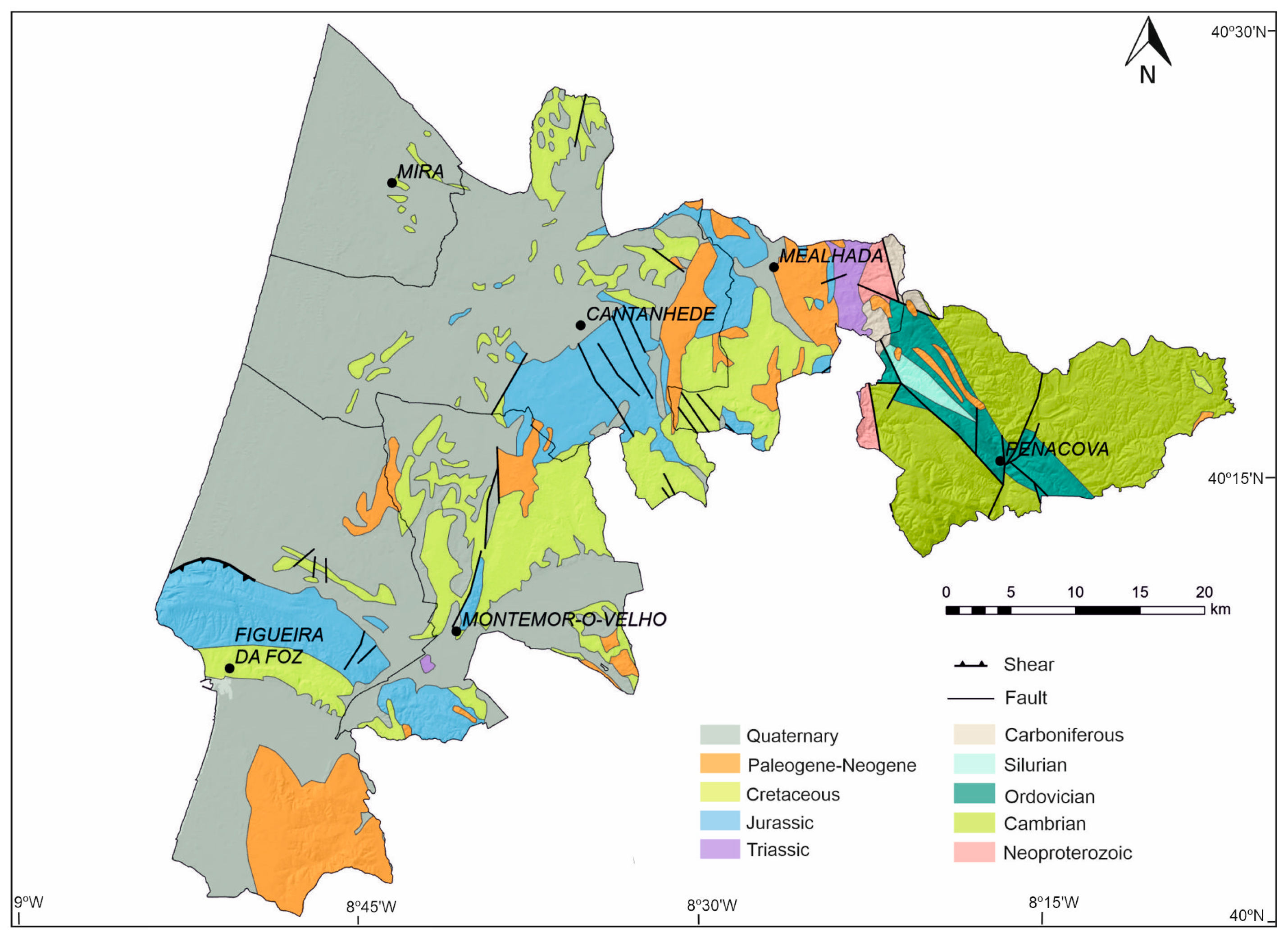
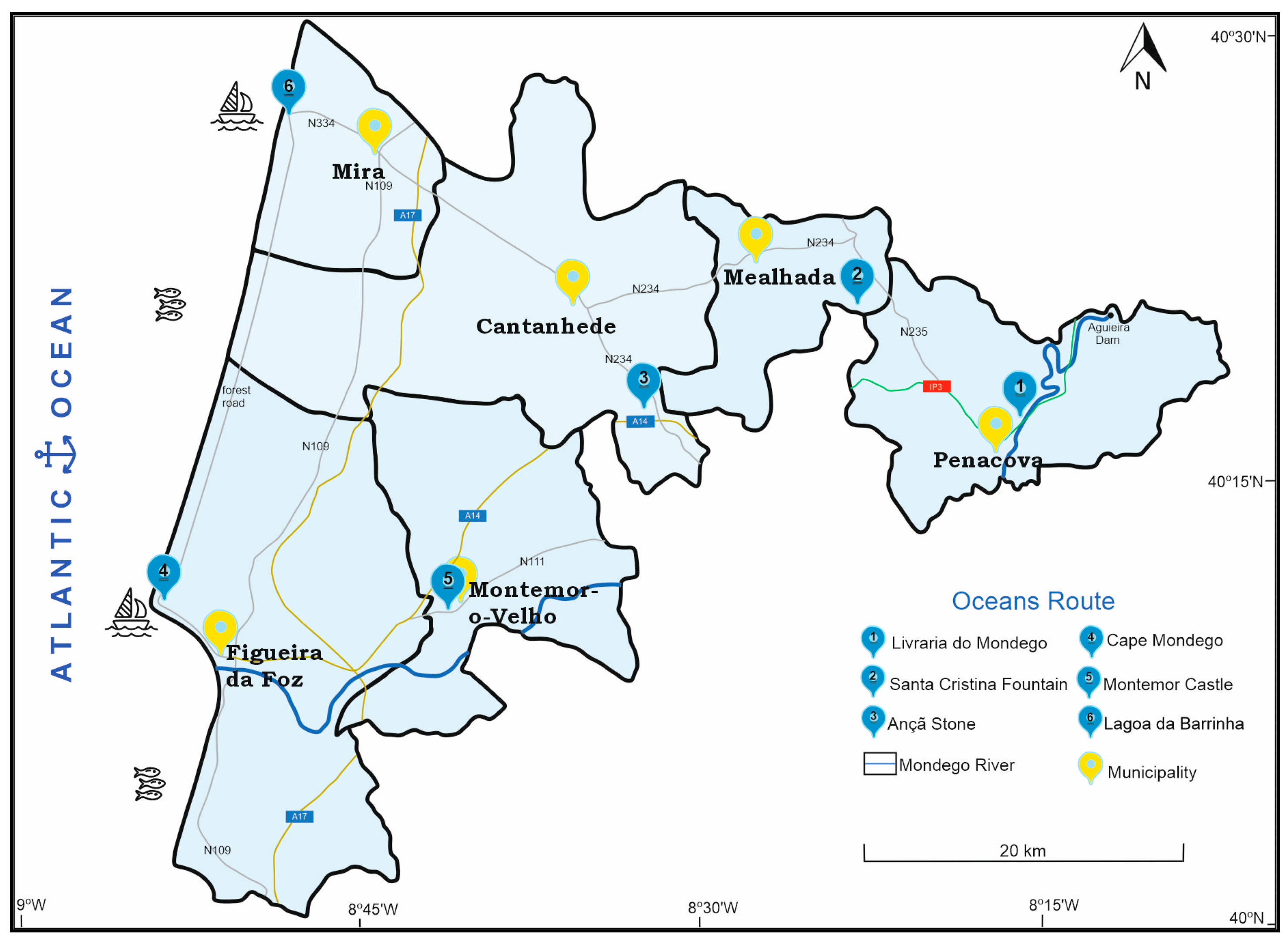
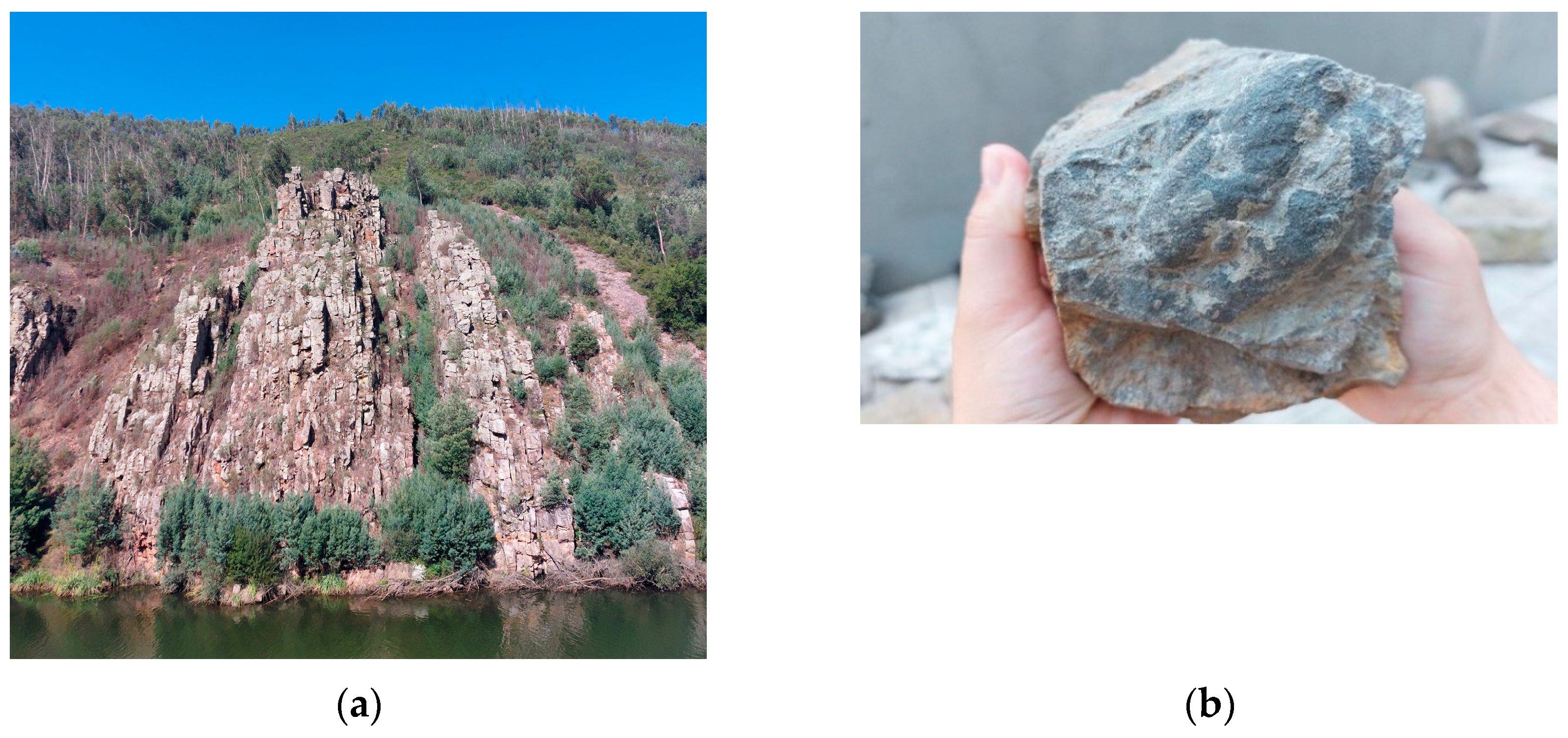

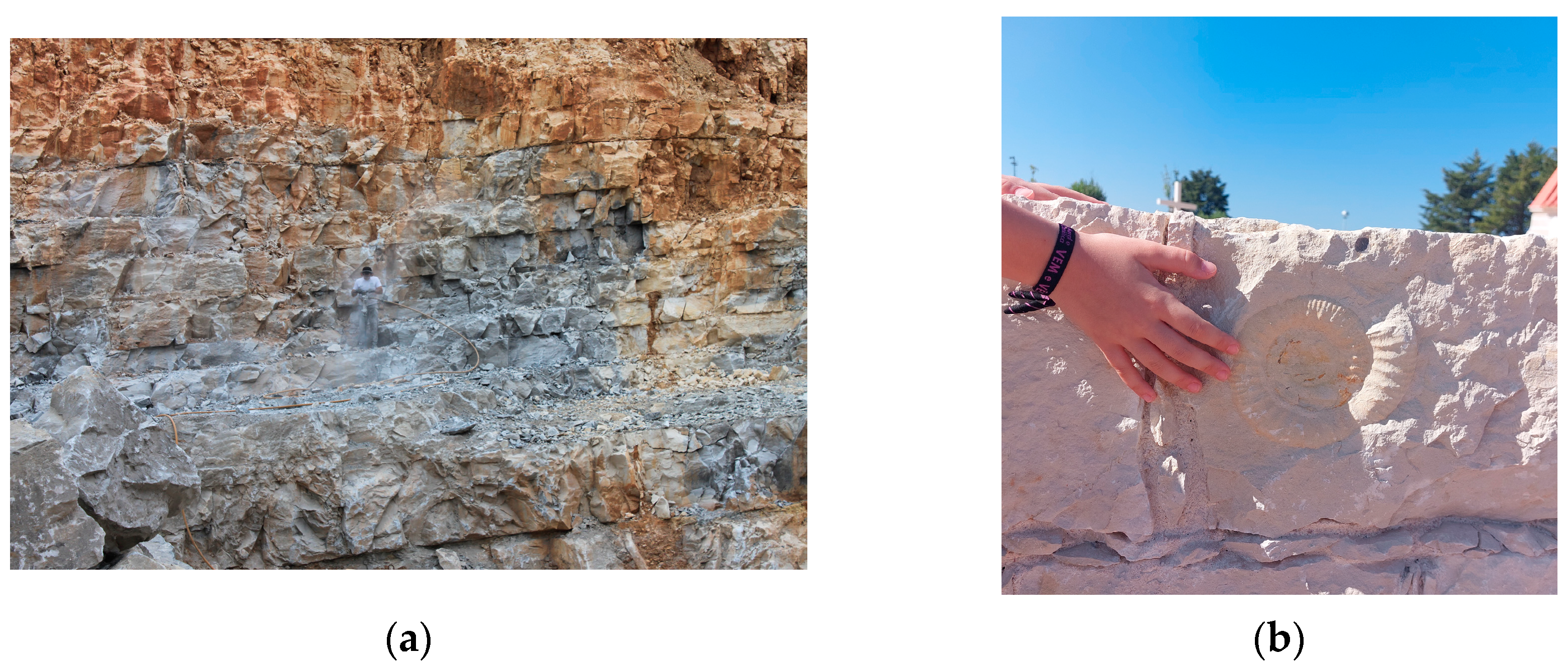
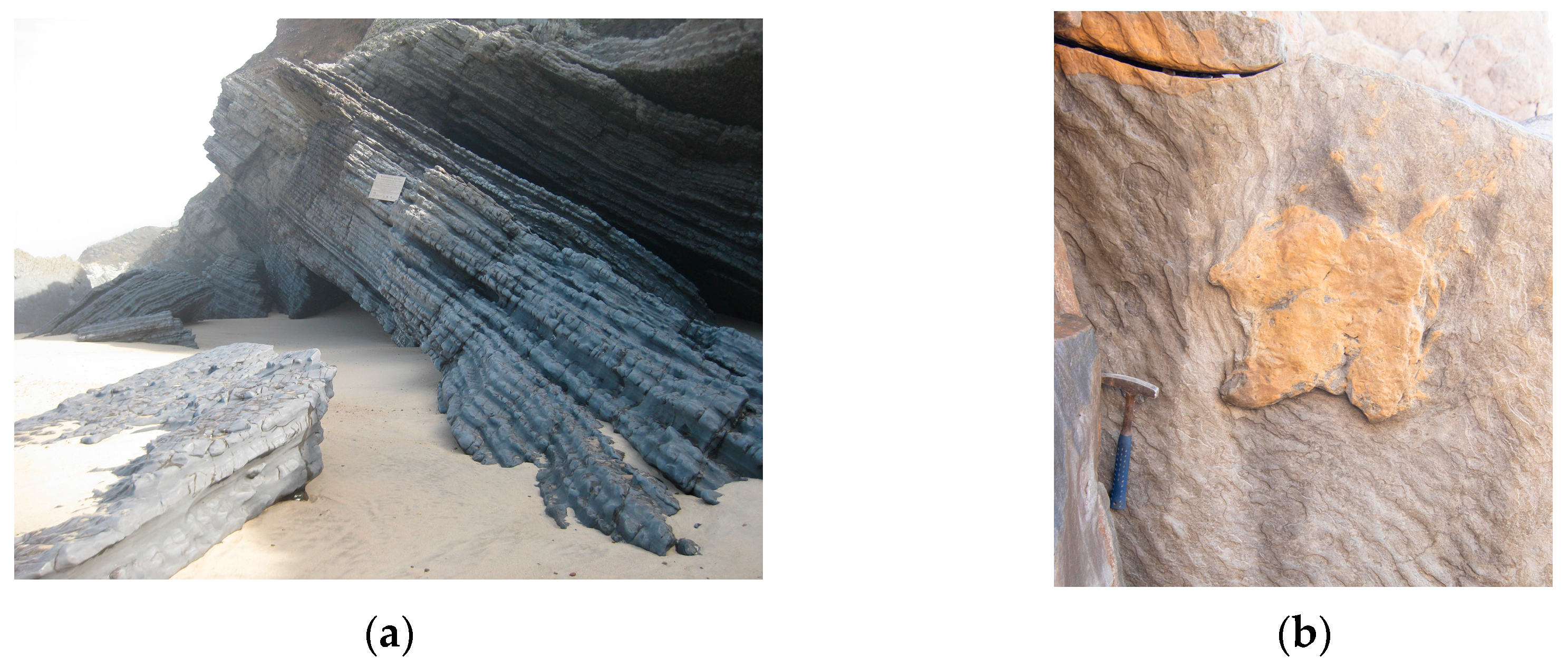


| Geological Sites | Geoheritage Type | Potential of Use | Relevance Scale | Typology |
|---|---|---|---|---|
| “Livraria do Mondego” | Paleontological Stratigraphical Tectonic Geomorphological Sedimentological | Educational Touristic | National | Area |
| Santa Cristina Fountain | Paleontological Stratigraphical Hydrogeological | Scientific Educational Touristic | Local | Area |
| “Pedra de Ançã” | Paleontological Stratigraphical | Educational | National | Point |
| Cape Mondego | Paleontological Stratigraphic Sedimentological Geomorphological | Scientific Educational Touristic | Global | Complex Area |
| Castle of de Montemor-o-Velho | Geomorphological | Educational Touristic | Local | Viewpoint |
| “Lagoa da Barrinha” | Geomorphological | Touristic | Local | Point |
| Geological Sites | Issues/Abilities | Grades (Ages) |
|---|---|---|
| “Livraria do Mondego” | Land in transformation - Relate the expansion and destruction of the ocean floor to the theory of plate tectonics (boundaries between plates) and the constancy of the Earth’s volume and mass | 7th (12–13) |
| Santa Cristina Fountain | Sedimentation and sedimentary rocks - Explain the importance of fossils (age/facies) in relative dating and the reconstitution of palaeoenvironments | 11th (16–17) |
| “Pedra de Ançã” | Land in transformation - Explain processes involved in the formation of sedimentary rocks (sedimentogenesis and diagenesis) presented in different media (schemes, figures, and texts) | 7th (12–13) |
| Cape Mondego | Geology and methods - Use principles of geological reasoning (actualism, catastrophism, and uniformitarianism) in interpreting evidence of Earth-history facts (stratigraphic sequences, fossils, rock types, and landforms) | 10th (15–16) |
| Castle of de Montemor-o-Velho | Society/nature/technology - Recognize and evaluate the natural and cultural heritage—local, national, etc.—and identify the natural elements in a landscape (e.g., geosites) | 4th (9–10) |
| “Lagoa da Barrinha” | Water, air, rocks, and soil—terrestrial materials - Interpret diverse information about the availability and circulation of water on Earth, enhancing your knowledge from other disciplines (e.g., history and geography of Portugal). | 4th (9–10) |
Disclaimer/Publisher’s Note: The statements, opinions and data contained in all publications are solely those of the individual author(s) and contributor(s) and not of MDPI and/or the editor(s). MDPI and/or the editor(s) disclaim responsibility for any injury to people or property resulting from any ideas, methods, instructions or products referred to in the content. |
© 2024 by the authors. Licensee MDPI, Basel, Switzerland. This article is an open access article distributed under the terms and conditions of the Creative Commons Attribution (CC BY) license (https://creativecommons.org/licenses/by/4.0/).
Share and Cite
Custódio, S.C.; Henriques, M.H.; Rosado-González, E.M.; Vaz, N.M.; Sá, A.A. Selected Geoheritage Resources of “Atlantic Geopark” Project (Central Portugal). Geosciences 2024, 14, 81. https://doi.org/10.3390/geosciences14030081
Custódio SC, Henriques MH, Rosado-González EM, Vaz NM, Sá AA. Selected Geoheritage Resources of “Atlantic Geopark” Project (Central Portugal). Geosciences. 2024; 14(3):81. https://doi.org/10.3390/geosciences14030081
Chicago/Turabian StyleCustódio, Salomé C., Maria Helena Henriques, Emmaline M. Rosado-González, Nuno M. Vaz, and Artur A. Sá. 2024. "Selected Geoheritage Resources of “Atlantic Geopark” Project (Central Portugal)" Geosciences 14, no. 3: 81. https://doi.org/10.3390/geosciences14030081
APA StyleCustódio, S. C., Henriques, M. H., Rosado-González, E. M., Vaz, N. M., & Sá, A. A. (2024). Selected Geoheritage Resources of “Atlantic Geopark” Project (Central Portugal). Geosciences, 14(3), 81. https://doi.org/10.3390/geosciences14030081









